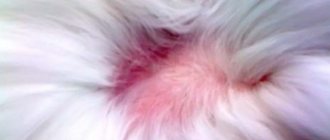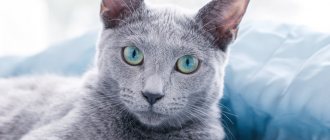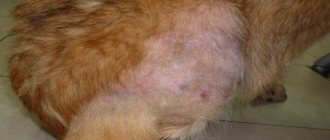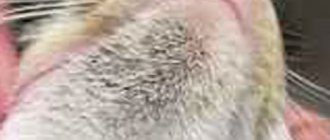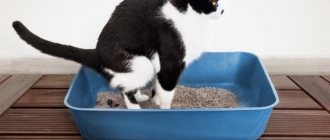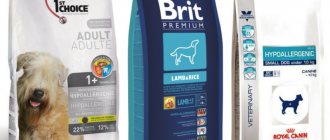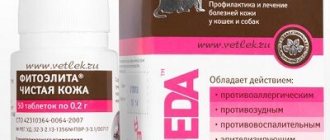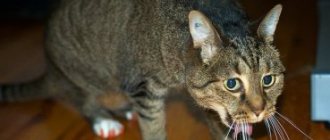If a cat loses some of its fur, this is normal and a natural process. However, in situations where the amount of hair on the floor and surrounding objects increases, and the hairiness of a domestic cat, on the contrary, decreases, this is a reason to think about the state of the animal’s health.
Some causes of hair loss are completely harmless, but others can be serious.
So, the cat's hair is falling out. The main reasons can be: natural (molting, age-related), health problems (poor diet, hormonal imbalance, allergies), parasites (worms, lice eaters, subcutaneous and scabies mites), problems with the immune system.
What to do immediately if you discover baldness on a pet
For reference! It doesn't matter what breed the cat is, all breeds lose hair, including hair from the neck. Neither flock or velor sphinxes, nor other noble breeds, nor farm animals with stronger immunity are immune from this phenomenon.
Why is this happening? In order to answer this question, you need :
- Completely examine the animal, and not only the neck, but also all its parts: ears, paws, tail.
- Pay close attention to any damage to your cat's skin. Perhaps there is no baldness there, but there are wounds similar to those on the neck.
- Analyze how you care for your pet. This may be the reason why your cat is losing hair on its neck. Therefore, it is advisable to make a list of the foods you keep your cat on. Add care products, such as shampoo, to the list. Remember and write down whether you give your cat medications: fleas, worms, vitamins, contraceptives or behavior-correcting medications.
Why is all this important? To accurately diagnose and begin treatment.
Pooh-eaters
These parasites are also called lice eaters. Their food consists of particles of animal hair and skin. They are very difficult to spot as they are much smaller than fleas. Therefore, you can understand that a pet has acquired them only by the symptoms: the pet is nervous, sleeps poorly, bites its fur coat, stops listening, itches endlessly and loses its fur. If such signs occur, it is necessary to point the lamp at the animal and wait 10 minutes. If these parasites are present on the pet’s body, they will definitely come out closer to the warmth. And then it will be possible to see exactly why the cat’s clumps of hair fall out.
What are the causes of hair loss
The fact that a cat's neck hair is falling out is a sign of illness. What could it be? There are only 3 options:
- Skin problem,
- Internal diseases of organs,
- Stress.
Skin problems . Problems can also arise due to injection with a syringe. A lump forms under the cat's skin, causing hair to fall out. Contact dermatitis is another cause. This is a cat's reaction to allergens. But due to fleas and lichen, hair on the cat’s neck, back or tummy can also fall out greatly.
Organ diseases . Thyroid disease, blood problems, hormonal imbalances - all this becomes a serious problem due to which the pet suffers, and, as a result of the disease, hair loss on the neck and body.
Stress .
Any change in a cat's life leads to stress. For example, a bald spot may appear when moving to a country house or changing food. This also includes age-related changes, the birth of children, etc. But most often, hair falls out not only on the neck, but also behind the ear and near the eyes. In this case, you can often observe that the hair on the cat’s neck falls out in clumps.
Parasites
It is a mistake to think that an animal can become infected with parasites only by living outdoors. Therefore, preventive measures are often not applied to pets that do not leave the apartment. But parasites can get into the house on people’s clothes and shoes. And then safely transfer to the animal. Several signs that help determine that an animal has parasites:
- The pet's behavior becomes nervous, it itches very often and severely, which even leads to the appearance of wounds.
- The hair falls out, but not very much.
- The direct presence of parasites on an animal is the most obvious sign of their presence.
What measures are needed to prevent the problem?
The problem has been identified, the cat is scratching its neck and hair is coming out. And the bald patches all over the baby’s body say that you can’t cope with the problem on your own. What to do? The best thing to do is go to a veterinary clinic. An accurate diagnosis is needed. Tests and monitoring of the cat’s general condition will help you find out exactly what is causing hair loss from the kitten’s neck.
You may have to change the food or cleanse your pets of parasites. Only a doctor can decide whether vitamins or medications are needed to treat your cat.
Immunity problems
If an animal has problems with immunity, the fur is the first to suffer from this. This situation most often occurs when an animal is recovering after a long, protracted illness or surgery. In this case, nothing can be done. You just need to wait until the body itself starts working as before. However, in some cases it won't hurt to get some help.
In such situations, it is recommended to temporarily transfer the cat to a balanced natural diet of the highest quality. If a decline in immunity is the cause of hair loss in a cat, treatment by a veterinarian may be prescribed by adding a complex of vitamins and minerals to the diet. At such times, beneficial substances are very relevant, but a specific drug must be prescribed by a veterinarian. Otherwise, you may cause even more harm to your pet.
As you can see from the article, there can be many reasons for hair loss, and the symptoms are not always obvious and similar to each other. Therefore, a veterinarian must determine why a cat’s fur falls out in clumps and how to treat this or that disease. Trying to make a diagnosis yourself can only worsen the animal’s condition.
As soon as a question arises and concern arises about why the pet feels pain and why the cat’s hair is falling out on its back, it is better to immediately go to the veterinary office. There they will do tests, conduct research and thoroughly examine the animal. Skin diseases spread quite quickly, so do not delay your visit. In addition, all this is accompanied by severe itching. As a result, the pet begins to scratch itself, wounds appear on its skin, which can lead to infection.
What to do if your cat is losing hair and has sores?
Parasites on a cat's body
If the owner notices sores on the pet's skin, it should be examined. Diseases do not require immediate contact with a veterinarian, and in some cases the felinologist is able to help the pet himself. Examination of the fur reveals scurrying insects, as well as their excrement in the form of black dots and whitish eggs. The most convenient option is to apply Spot-on drops to your back and let it dry to prevent licking off. To relieve itching, use antipruritic sprays Stop-Itching or Contravance.
Diet
If there are no ectoparasites, the diet should be analyzed. Stop treats, stop begging. Change the food to a hypoallergenic one, for example, dry food based on lamb and rice. If the diagnosis is correct, improvements become noticeable after 14 days. The situation is more complicated for adherents of natural products. You will have to replace all the components of the food with those that the cat has never eaten. Choose a vitamin and mineral supplement. In such a situation, it will not be possible to do without qualified help.
Animal conditions
At the same time, they analyze the conditions of detention. Place household chemicals in places inaccessible to the animal. Stop smoking in the presence of your pet, and you may have to stop using new cosmetics. Use a humidifier. They remove ornamental plants to places inaccessible to the cat or make a choice in favor of one of the two creatures. Regularly carry out wet cleaning and vacuum thoroughly.
Itching mites (subcutaneous)
If you suspect infestation with tick mites, use the same drops that are used to expel fleas, only more often. To relieve itching, antihistamines are used: Suprastin or analogues, or Stop-itching in the form of an oral suspension or spray. The use of potent acaricidal agents is carried out after consultation with a veterinarian.
Fungal infections
Fungal infections are eliminated under the influence of antimycotics. Most often, in this case, not only the neck, but also other parts of the body are affected. The best option is to treat the cat with Imaverol. External agents in the form of ointments and oral drugs in the form of tablets should not be used independently.
Ringworm is not something to joke about; children, as well as adults with weakened immune systems, can become infected, so the best option is to go to a hospital.
How to eliminate stress
To eliminate the stress factor, it is necessary to have a conversation with children so that they do not torture the animal, and also to influence other pets who terrorize the animal. To calm the cat, they are given oral medications: Stop-Stress, Kot Bayun or Vetspokoin.
How to understand that this is a normal shedding
If the cat is cheerful and active, and its fur is smooth and shiny, but remains in clumps on furniture and other surfaces, most likely this is normal shedding. Shedding is a completely natural period in a cat's life. In an adult animal, it lasts from several weeks to two months, but the first molt can last for a whole year.
You can tell that a cat is shedding normally by the following signs:
- wet nose;
- ears and paw pads are warm, but not hot;
- appetite is not impaired;
- the cat does not itch or chew its fur;
- Bald spots do not form on the animal's body.
Shedding is a natural process in cats
Adult cats that live outdoors usually shed twice a year, in spring and fall. Cats that do not leave the apartment all year round practically do not feel the change of seasons, so molting may become blurred for them. Increased dryness of the air, especially if the cat likes to lie on hot radiators in winter, can prolong the molting process up to three months, so you need to humidify the room.
At the age of 5-8 months, the kitten begins to change from baby fluff to adult fur, and the color may noticeably change. At this time, the baby especially needs care and healthy nutrition.
Of all the cat breeds, only completely hairless Sphynxes never shed. In other cases, molting occurs one way or another. Cats with a dense undercoat shed more often and more intensely - British, Siberian, Persian and Maine Coons. Fluffy cats, for example, Burmese, Angora, Somali, have less dense undercoat, although they grow large collars by winter. Bengal, Siamese, Abyssinian, and Singaporean breeds shed moderately - they have almost no undercoat. In the usual sense, cats of such breeds as Devon Rex, Cornish Rex and La Perm, as well as overgrown Sphynxes, do not shed. Only a few times during their lives they shed, up to the formation of bald spots, changing their fur completely. However, some of them are prone to traditional seasonal molting.
The cat has sores on the neck and itches: how to treat dry sores
If an independent fight against itchy sores and hair loss does not lead to success, seek veterinary help. The specialist conducts a clinical examination, collects anamnesis, and prescribes laboratory tests.
Tests for parasitic skin lesions and dermatophytes in cats
How else can you help an animal if nothing helps?
Depending on the final diagnosis, he develops a treatment strategy using potent medications and feed additives in addition to those discussed above:
Physiological reasons
If your animal's hair has become thinner and you see hair everywhere, don't panic. Sometimes the reasons can be quite natural:
- molt. If an animal constantly lives in an apartment, then its natural biorhythms are disrupted, and the molting process in spring and autumn can drag on for 2-3 months. If there is a lot of hair loss, but there are no other signs of pathology, the animal is healthy;
- age. Older cats do not have thick fur. Bald spots and patches of long hair often appear on the body. This does not pose any danger if you regularly examine the animal and know for sure that it does not have any age-related diseases;
- stress. Many people mistakenly believe that cats can easily endure any life situation, but in fact the animal is distinguished by very high sensitivity and a delicate nervous system. Any change in the living conditions of an animal can result in severe hair loss, which can even lead to complete baldness. The pet may stop eating or may suddenly change its diet, constantly feel drowsy or, conversely, be overly active;
- pregnancy. In this position, the cat may lack vitamins, which may result in some areas becoming bald. Therefore, during pregnancy and breastfeeding, it is very important to provide the cat with proper nutrition, as well as introduce vitamin supplements into the diet;
- poor nutrition. Hair often falls due to a lack of B vitamins. This phenomenon is often observed with natural nutrition and when feeding cheap food. If you feed your animal fried potatoes or sausage, this can cause not only hair loss, but also lead to disruption of the gastrointestinal tract.
The cat began to lose hair on his neck and behind his ears.
Daughter Sophia (07/11/08) and son Danilka (03/09/11) :)))
02.25.10 13:41 Reply to the message The cat began to lose hair on its neck and behind the ears by Tella222
Appearance is an eternal letter of recommendation
02.25.10 14:41 Reply to the message The cat began to lose hair on its neck and behind the ears by Tella222
Freedom for Angela Davis!
02.25.10 16:58 Reply to the message The cat began to lose hair on its neck and behind the ears by Tella222
The main difference between animals and people is that animals do not keep people in their homes. Although cats may not agree with me.
02/25/10 18:06 Reply to the message The cat began to lose hair on its neck and behind the ears by Tella222
Corrected by Merigold (25.02.10 18:11)
02/27/10 12:55 Reply to the message The cat began to lose hair on its neck and behind the ears by Tella222
Corrected by user Ryzhinka (27.02.10 13:17)
02/27/10 23:31 Reply to message Re: The cat began to lose hair on its neck and behind the ears of user dm666
Daughter Sophia (07/11/08) and son Danilka (03/09/11) :)))
02/27/10 23:35 Reply to message Re: The cat began to lose hair on its neck and behind the ears by user Tattunhamon
In response to: Sorry, I didn’t quite understand. The cat’s entire neck is bald, it’s starting to fall out behind the ears, but you haven’t been to the doctors yet and have started a problem? What to do. Run to the doctor.
Daughter Sophia (07/11/08) and son Danilka (03/09/11) :)))
02.28.10 13:30 Reply to message Re: The cat began to lose hair on its neck and behind the ears by user Tella222
El saber no ocupa lugar
02.28.10 13:54 Reply to message Re: The cat began to lose hair on its neck and behind the ears by user Tella222
Well, I dropped everything and ran. The cat is really scary to look at, but the child is more precious to me, and my husband doesn’t care about the cat.
It's amazing how you treat an animal, which is completely up to you! Why did you even get a live cat? Are you too lazy to pick it up? That’s right, the cat is not a child, he won’t say that he’s bothering him and he won’t tell on his mother to the neighbors.. They dragged the husband in for some reason.. And the baby seems to spend 24 hours a day at your breast continuously, since you can’t “throw away”
Shedding
If a cat's fur falls out in clumps, the reasons may be very trivial. Animals in the wild change their coat twice a year: in autumn and spring. In domestic animals, this process is disrupted, since they are removed from their natural habitat. For example, in the fall, when all animals in nature build up a warm undercoat for winter, the reverse process begins in domestic cats. This is due to the fact that the heating is turned on during this period of time. The air in the apartment becomes hot and dry, so your pet is in a hurry to get rid of excess fur. Moreover, at home, the molting process can take much longer than in natural conditions. This is completely normal. The fact that an animal is actively changing its coat is not a cause for concern.
All you need to do is make sure that your cat's diet is balanced and rich in vitamins and minerals. If there are not enough of them in the diet, you can compensate for this deficiency. It is enough to purchase special vitamin and mineral complexes at any pet store.
You need to comb the animal more often. On normal days, sessions should be carried out once every 7-30 days, but when the molting period begins, the procedure becomes daily. And if your pet has long hair, you will have to comb it twice a day. And even this will not get rid of the daily use of a vacuum cleaner.
The cat has sores on its head and hair has come out: Causes
Many factors can contribute to hair loss and the appearance of wounds on a cat’s head, neck, withers and other parts of the body:
- Flea infestations and other parasites can cause itching, self-induced alopecia, and dermatitis.
- Allergy. It can be different: to components of the diet, to something from the environment.
- Contact dermatitis. It often occurs at the site where flea drops are used or when medications are administered subcutaneously. Crusting is often reported with Baytril injection in cats.
- Other inflammatory and non-inflammatory processes in the dermis.
Treatment of hair loss in cats
Hair loss in cats can be eliminated with the help of comprehensive measures - drug treatment, adjustments to living conditions and diet. To determine the cause of your cat's hair loss, you need to consult a veterinarian. He will prescribe the appropriate treatment.
Hair loss treatment is carried out comprehensively
Medicines
The first step to a beautiful and fluffy coat is removing parasites. First, an insecticidal treatment is carried out to destroy lice, fleas, and ticks. For this purpose, drops are purchased at the veterinary pharmacy. They should be used strictly according to the instructions, without exceeding the dosage. If there are a large number of fleas, the treatment is repeated after 7-10 days.
Dichlorvos and other chemicals not intended for cats are strictly prohibited. The use of medicinal products for humans is also prohibited. Even safe paracetamol can cause serious complications in a cat.
3-7 days after the procedure for treating external parasites, a drug is given to remove helminths. The tablet should be given in the morning, with food. The dose is calculated according to the cat's weight.
Sedatives are used to reduce stress levels. Antibacterial and antifungal drugs are used to combat bacterial and fungal infections. For the proper functioning of immune cells - immunostimulants.
All medications, dosage and course of therapy are determined by a veterinarian depending on the cause that caused hair loss.
Give your pet only the medications intended for it.
The use of medicated shampoos and special preparations
In addition to taking medications, antiseborrheic shampoos, ointments and antiseptics are prescribed to treat suppurations.
Medicated shampoos are mainly designed to combat parasites. They contain not only a substance that can get rid of parasites, but also relieve itching and irritation in the cat. Flea shampoo for pets will also help heal small wounds and scratches on his body. Special flea shampoos have been created for kittens, consisting of herbal extracts, vitamins and essential oils.
Anti-dandruff shampoos for cats are designed for animals with problem skin. Its composition, like the anti-lichen shampoo, includes antifungal drugs and special components that will eliminate dandruff, flaking and crusts that appear due to seborrhea.
Anti-allergenic shampoo is intended for cats suffering from frequent manifestations of allergies on the skin. This shampoo contains no allergy-causing ingredients and also prevents irritation from dandruff or any external irritants.
Diet for hair loss
For effective hair growth and healthy skin, your cat needs a large amount of protein. About 30% of daily protein intake is used by the animal's body to renew and form skin cells. Not getting enough high-quality protein in your diet or consuming protein that is poorly absorbed can lead to brittle, thinning hair and hair loss.
With a natural diet, the basis of the diet for 4-5 months will be: lean meat (pork is excluded), lean sea fish, semi-cooked without bones, lungs, heart, liver, stomach and other offal, kefir, low-fat sour cream, small quantities of vegetables, steamed cereals boiling water or broth.
When feeding commercial dry and wet food, it is necessary to choose a high-quality product intended for allergy sufferers.
Vitamins A and E are also very important for maintaining a healthy cat's coat and preventing excess shedding. They regulate cell growth and act as natural antioxidants. A lack of these vitamins can lead to disruption of the production of keratin, which is the main component of hair. B vitamins and biotin will help restore fur faster.
For a beautiful coat you need vitamins and a balanced diet.
The cat has a sore on the neck and hair is falling out: Diagnosis
There are several methods to determine the cause of a cat’s illness:
- Flea feces detection test.
- Studying the cellular composition of the skin using fingerprint smears, scrapings, and tape.
- Scrapings to identify ectoparasite mites .
- Cultures to identify bacteria and fungi.
- Histological examination of the skin.
- Other studies are used less frequently; the decision to prescribe them is made by the doctor. Remember that you have the right to ask the doctor to give you an explanation of why this or that procedure is needed.
Watch the video: Veterinarian advice - Skin diseases in cats and their diagnosis
Poor nutrition
At any age, the animal's diet must be balanced. Feeding from your own table is the most common mistake a pet owner makes. With this approach, the animal’s bowl may contain everything that is strictly prohibited for cats: fried foods, sausages, various scraps, leftover salty and fatty foods.
The answer to the question of why a cat's fur falls out in clumps may be a simple desire to save money. For example, the owner buys dry food from the cheapest line. Yes, such food will help your pet get enough, but it will also bring many health problems. After all, its composition is not always optimal, so the effect of such food on the animal’s body can be destructive.
It is worth understanding that choosing a diet is a very important process. It is better to choose dry food from the super-premium or premium category. This diet is balanced and contains all the necessary microelements. Although it costs, of course, more than advertised budget products. But using low-quality food will cost much more, as it will provoke a trip to the veterinarian and long-term treatment.
To determine why a cat’s hair is falling out in clumps, and to understand that the reason lies precisely in the food and improper diet, it is necessary to take into account the following symptoms:
- the main pieces of hair fall out on the back, neck and tail;
- on all other parts of the body the fur began to fade;
- discharge appeared from the eyes, and they themselves became cloudy;
- the ears are inflamed and itchy;
- The bald spots that have arisen at the site of the fallen tufts are inflamed and itchy, the layers of skin in these places have begun to peel off, the animal scratches itself so that sores appear.
The cat itches until it hurts and the hair falls out: How to treat it at home?
Every owner should understand that many drugs that can be used by humans and other animals cannot be used on cats.
For example, skin lesions are often treated with Yam BK ointment. This is strictly forbidden, since the tar contained in this drug is toxic to cats.
Like this article? Read other materials about cats on our website: How to give medicine to a cat? Tips for ensuring comfort for a cat - https://strazhchistoty.ru/cleanup/cleancats/kak-dat-lekarstvo-koshke.html How to learn to understand your cat (Practical tips) - https://strazhchistoty.ru/cleanup/cleancats/kak -ponimat-koshku.html
How can you help yourself without causing harm?
Try to limit access to the body area if the cat injures itself. A protective collar or blanket can help with this.
Trim your cat's claws or apply safe anti-scratch pads.
Itching can be controlled using a suspension or spray with the same name Stop Itching . It is important to understand that you will only remove the symptom, and after a course of the drug the problem may return.
The crusts can be soaked and removed using saline or Chlorhexedine.
Also, if there has been no treatment for fleas and ticks for a long time (the apple tree is a month old), it is worth doing it. Suitable drugs: Stronghold, Lawyer, Helmintal, Inspector, Bravecto.
And, of course, we recommend taking your pet to see a doctor as soon as possible.
Alopecia symptoms
You can recognize alopecia in a pet by the following signs:
- The fur falls out excessively, in clumps. Bald spots in cats appear mainly behind the ear, in the neck, back, and on the tail.
- The skin in these places may have its usual pink color or turn red, sores or scabs may appear there.
- Check your pet's reaction to touching the bald spot: perhaps the spot hurts or itches.
- Check if the animal has symmetrical bald spots.
If you notice these symptoms, you should urgently seek professional help from a veterinarian. Otherwise the disease will progress.
List of drugs for the treatment of dermatitis in cats
After determining the factor that caused the damage to the skin and coat, the veterinarian may prescribe one of the drugs or a combination:
- Cortavance , Exekan to relieve itching and inflammation.
- Sinulox to eliminate bacterial infection.
- Terbinafine or Lyme sulfur against fungi.
- Shampoo for itching or inflammation. For example, Green Doctor, Globalvet with chlorhexedine.
- Drops on the withers against parasites: Broadline, Inspector, Bravecto.
- Ointments, creams or emulsions, for example Fucidin.
- Vitamins and other nutrients for speedy skin restoration, for example Laveta super or Supercoat.
- Veterinary diet from Royal Canin, Hills, Proplan, Monge or Farmina aimed at improving the quality of coat and dermis.
Is it normal for a cat to itch?
If an animal licks itself or itches after sleep, this is quite normal. The cat is just tidying up. After the cat has eaten deliciously, she begins to actively lick herself. This is sometimes not liked by owners who feed their animals natural food. Because, having licked itself and combed itself, the animal actively smells of the food it just ate.
It is especially unpleasant if a curious animal looks into the trash can. Sometimes cats can pull out the remains of herring or other fish and eat them. And then lick yourself thoroughly. After this, the cat will actively smell of fish for some time.
If the cat itches constantly and licks itself until its hair falls out, you need to take your pet to the clinic to rule out serious diseases.
Signs of a pathological condition of an animal
The itching may be skin-related or your cat may have itchy ears. In the latter case, the animal will scratch not only the auricle, but also try to put its paw into the ear canal and scratch the place that bothers it.
In addition to the fact that the animal is actively itching and gnawing at itself, as if trying to gnaw something out from under the skin, an attentive owner may notice:
- deterioration of the animal's fur and its loss;
- the pet's plaintive meowing when trying to scratch itself;
- red spots, rashes, excoriation (scratching) and ulcers on the skin;
- dandruff, scab, oily scales;
- excrement of parasites and the parasites themselves;
- constant licking of paws;
- scratching and biting one's own skin.
If the owner discovers something similar in his pet, he should take him to the veterinary clinic. As long as the changes are small, it is quite easy to help the animal. As the process progresses, it will take much more time and effort to heal your pet.
Causes of the phenomenon
The most common reason that an animal bites into its own rump is flea bites. In this case, you need to rid your pet of annoying insects as soon as possible.
Ear mite parasitism leads to severe itching in the auricle. The animal tries to bury its hind paw deeply and scratches the auricle. It rubs its head against pieces of furniture and shakes it, as if trying to shake something out of its ear.
In addition, the owner may notice an unpleasant odor from the animal’s ear, discharge of a brown substrate, and hearing impairment. With otitis (inflammation of the ear in a cat), the symptoms will be approximately the same.
When trying to scratch its ear, the cat may meow pitifully.
When a cat's skin is parasitized by a lice-eater mite, the animal's hair deteriorates and falls out. The skin is very itchy, the animal scratches the skin vigorously, and crusts appear on it. The waste products of parasitic insects are found in the wool.
Sarcoptic mange is a parasitic disease caused by mites that burrow into the deep layers of the skin. At the initial stage, sarcoptic mange is asymptomatic. Its main symptom is frequent scratching of the animal. Then redness appears on the skin.
As the disease develops, quickly bursting blisters appear on the animal’s face and near the ears. The itching at this time is very strong, the animal actively itches, spreading parasites throughout the body. The skin in the affected area dries and becomes bald.
Deep wounds appear on the animal's tail and paws, oozing ichor.
Notoedrosis, or cat scabies, is another tick-borne infection. It manifests itself as severe itching. The first signs of this disease are loss of hair around the cat's ears and very severe itching in this area.
Soon the ticks “settle” in the animal’s abdomen, perhaps moving from the muzzle while the animal sleeps, curled up in a ball. The fur on the animal's belly falls out, the skin thickens, becomes covered with pustules and scabs.
The cat constantly licks and scratches the affected areas. Demodectic mange and cheyletiellosis cause similar symptoms.
Pyoderma, fungal infections, and autoimmune diseases lead to the appearance of various rash elements on the animal’s skin (vesicles, pustules, scabs, ulcers, erosions) and severe itching.
Hormonal imbalances can lead to itching and the appearance of a brown scab on the animal's tail and croup area.
Intestinal diseases or helminth infections in severe cases also cause severe itching. But, in addition to the fact that the cat is itching, the owner may notice a deterioration in her mood, a decrease in appetite and stool disorders. And sometimes vomiting.
Allergies are one of the most common reasons that cause a cat to actively scratch, scratching the skin.
Sometimes the cat itches a lot, but he doesn’t have any fleas or infections, and he doesn’t suffer from allergies. In this case, the itching may be psychogenic. As a result of stress, a cat may lose its fur, combing it out in clumps.
Treatment
Effective treatment without identifying the root cause is impossible. Therefore, the animal will still have to be taken to the veterinarian. At home, the owner can monitor the cleanliness of the animal’s skin and fur, scrupulously follow the veterinarian’s instructions, and provide the pet with balanced and high-quality nutrition and attention.
Source: https://nld.ru/koshki/bolezni/simptomy/cheshetsja-gryzetsja/
Why does a cat constantly itch and lick if there are no fleas?
Often, owners of furry beauties complain that the cat is constantly itching and licking, but there are no fleas.
In fact, there is nothing surprising about itchy skin, and it is not only caused by parasitic organisms. It is important to understand that itching is just a symptom.
It is useless to fight it, since first of all you need to eliminate the main cause that caused the unpleasant sensations.
Cat itches and licks: normal or not?
Why does a cat itch, and in what cases can this be taken as normal? Licking and scratching the fur after sleep and after eating is the most natural activity of a cat; clean animals spend a huge amount of time during the day caring for their fur. Cats can chew out the fur between their claws, which is not a pathology or a cause for concern.
If your cat is constantly licking itself and itching, you should seek medical help from a veterinary clinic. The examination is also necessary in the case when the pet pays attention only to a certain place on the body. For example, if a cat constantly scratches its neck, but there are no fleas.
Causes and possible diseases
If a domestic cat is itching, then the cause of this may be not only fleas, but also other pathological microorganisms. Severe itching can be caused by sarcoptic mange (scabies mites). With scabies, there may be damage to the skin on the ears, elbows, and ankles.
But there are other explanations for the fact that the cat is itching a lot, but there are no fleas. Only a veterinarian can make an accurate diagnosis.
Allergic reactions
Allergic reactions to new food or hygiene products can cause discomfort. Food allergies are not dangerous for the animal. It manifests itself as follows:
- the pet scratches its face;
- scratches ears;
- licks and bites limbs violently.
If a disease is suspected, the veterinarian will prescribe a diet to diagnose the specific component of the feed that is causing undesirable effects. Recommendations will concern changes in diet, as well as the use of medications to quickly eliminate symptoms.
Allergic reactions can also be caused by insect bites. At the same time, the pet begins to scratch the skin in the area of the bite. Summer also brings another danger to domestic animals - dust and pollen cause scratching. As a result of contact allergies, skin areas in the chest and abdomen are affected.
Bacterial and fungal inflammation
The skin and mucous membranes of both humans and their tailed friends contain a certain set of bacteria and fungi. Under normal conditions, these microorganisms do not cause any harm. However, as soon as the immune system weakens, their number begins to rapidly increase, which causes inflammatory diseases.
Fungal and inflammatory diseases are common causes of itching and the answer to the question of why a cat itches if there are no fleas.
Otitis
Otitis media is an ear infection that causes severe itching. With otitis media, the cat itches, but there are no fleas; in addition, the following symptoms appear:
- the tailed friend shakes his head, vigorously rubs his ears, scratches his muzzle;
- redness and swelling of the ears;
- discharge of purulent infiltrate from the ears.
If a domestic cat is itching, then the cause of this may be not only fleas, but also other pathological microorganisms.
Why do cats itch? Often the answer to this question lies in skin pathologies, since skin rashes cause discomfort and itching.
Skin diseases found in cats:
- pyodermatitis (secondary bacterial infection);
- cheyletiellosis (caused by mites of the genus Cheyletiella);
- notoedrosis (the source is microorganisms similar to Sarcoptes mites);
- demodicosis (infectious process due to the activity of demodectic microorganisms).
In the presence of such factors, scabies is accompanied by other external signs, in particular inflammatory reactions of the skin, as well as baldness.
Diagnosis and treatment for itching
- In order to know exactly why the cat is itching a lot, the veterinarian conducts the necessary diagnostic tests. For example, if an allergy is suspected, a blood test is taken for allergens, and in the case of a fungal infection, a bacteriological examination is carried out.
- Next, the doctor prescribes adequate treatment that concerns not the itching, but the disease itself. Treatment is medicinal in nature and includes the use of internal and local drugs. Depending on the cause, various drugs are used: antibiotics, antifungals, antihistamines to eliminate the allergic reaction.
- If redness and itching were caused by a food allergy or a reaction to the use of hygiene products, it is recommended to stop taking it and replace food, shampoo and other allergens.
Prevention of itching in cats
Prevention of scabies plays an important role; compliance with its basic rules will prevent the development of a pathological process with unpleasant symptoms. The main preventive measures include hygiene procedures: wet cleaning, washing the pet's bedding, washing its bowls.
It is imperative to clean the ears of your domestic animal and treat them with special preparations in a timely manner.
It is advisable to avoid contact between the cat and other animals. It is equally important to provide your cat with proper and balanced nutrition.
Now you know why a cat itches if there are no fleas. If you notice this behavior in your pet, be sure to consult a doctor, otherwise the animal may scratch the skin and introduce an infection into the blood.
Source: https://catspaw.ru/baza-znaniy/zdorovje/pochemu-koshka-postoyanno-cheshetsya-i-lizhetsya-esli-bloh-net/

